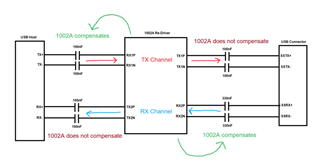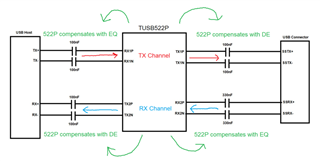Other Parts Discussed in Thread: TUSB1002A, TUSB1044, TUSB542
Hi Experts,
I see parts like the TUSB1002A and 1044 described as "linear" re-drivers while the TUSB522P is a "limited" re-driver. Which one is better to use in a USB system?
Thanks!
Shane
This thread has been locked.
If you have a related question, please click the "Ask a related question" button in the top right corner. The newly created question will be automatically linked to this question.
Our portfolio of USB re-drivers is divided into two categories, linear and limited. The fundamental difference between these two is that the output of a linear re-driver will always be a 1:1 linear function of the input. This restriction does not apply to a limited re-driver, which gives more versatility to what a limited re-driver can do for your signal.
A linear re-driver will only compensate for loss on the receiving signal path. This lets the TUSB1002A, TUSB1044, and all of our linear re-drivers recover a lossy signal that is received to produce a clean signal on the TX output. Here’s an example of how the TUSB1002A linear re-driver compensates for loss in a USB system.

You can see that the re-driver compensates for the signal coming in to the RX inputs of the device, but not for the signal on the TX outputs. This is a defining feature of every linear re-driver.
A limited re-driver can compensate for loss on both the receiving and transmitting signal paths. This lets our limited re-drivers like the TUSB522P and TUSB542 compensate for loss before and after the re-driver on both channels.

A limited re-driver like the 522P is able to apply De-emphasis (DE) to signals on the transmitting path. This will keep a USB signal clean after it exits the re-driver, unlike a linear re-driver that can only use equalization (EQ).